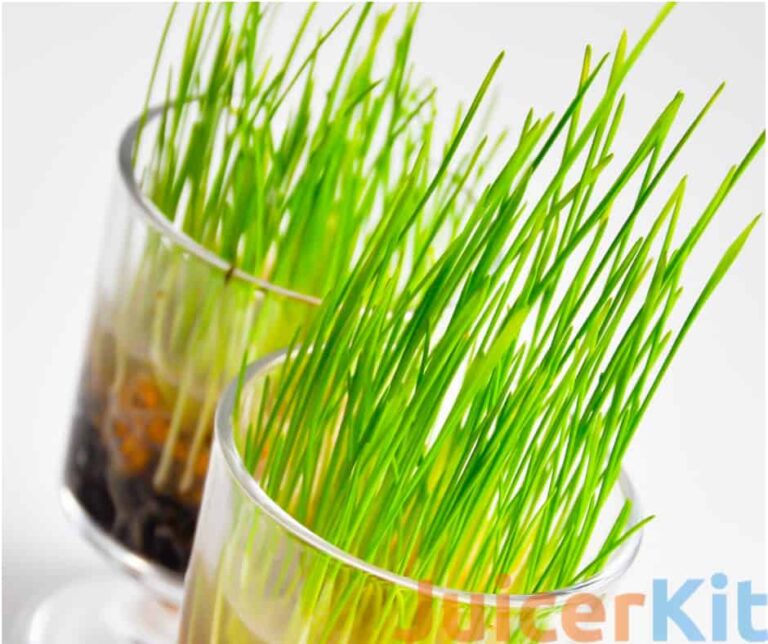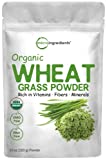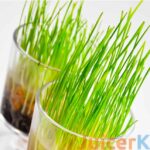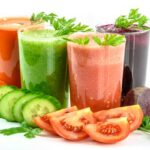We will also examine the nutritional content of wheatgrass and how it can help to support overall health. If you’re interested in wheatgrass but don’t know much about it, this article can help you choose the best way to try it.

Wheatgrass is the young grass of the wheat plant and has gained popularity as a superfood due to its rich nutritional profile. It is available in various forms, including wheatgrass powder and wheatgrass juice.
In this article, we will explore the question: Is wheatgrass powder as good as wheatgrass juice? We can arrive at a well-informed conclusion by examining their nutritional composition, bioavailability, impact on the digestive system, convenience, taste, cost-effectiveness, environmental impact, potential side effects, research evidence, and practical applications.
Wheatgrass Powder Has Similar Nutrients to Wheatgrass Juice
Wheatgrass powder and juice are known to have numerous health benefits due to their high nutrient content.
Nutritional Composition
Wheatgrass powder and wheatgrass juice both possess many nutrients that contribute to their health benefits. Wheatgrass contains vitamins, minerals, antioxidants, enzymes, and chlorophyll. However, the nutritional content can vary between the two forms due to differences in processing and preparation. Wheatgrass powder is typically made by drying and grinding the grass, resulting in a concentrated form. On the other hand, wheatgrass juice is extracted by juicing fresh wheatgrass blades. While both forms retain essential nutrients, the concentration may differ.
You make wheatgrass juice by extracting the liquid from fresh wheatgrass, while wheatgrass powder is made by dehydrating and pulverizing the wheatgrass into a fine dust. This method may result in a loss of some nutrients, but fear not, as wheatgrass powder is still a viable source of vitamins, minerals, and antioxidants.
Bioavailability and Absorption
Bioavailability refers to the extent to which nutrients can be absorbed and used by the body. When comparing wheatgrass powder and wheatgrass juice, the bioavailability of nutrients can be influenced by factors such as solubility and digestion. Wheatgrass powder, being a concentrated form, may require thorough digestion and may have lower water solubility, affecting nutrient absorption. On the contrary, wheatgrass juice is more readily absorbed by the body, as the nutrients are already in a liquid form.
Digestive System Impact
The digestive system plays a crucial role in breaking down food and extracting nutrients. Wheatgrass powder requires adequate digestion before the nutrients can be absorbed. This process involves the release of digestive enzymes and the breakdown of the powder’s fibrous components. In contrast, wheatgrass juice bypasses the need for extensive digestion. Thus allowing for quicker absorption of nutrients by the body. The liquid form of wheatgrass juice may be more gentle on the digestive system for anyone with sensitive stomachs.
Convenience and Shelf Life
When it comes to convenience, wheatgrass powder offers certain advantages. You can easily store it for longer periods without refrigeration. This makes it a convenient option for those with limited access to fresh wheatgrass. Additionally, you can use wheatgrass powder in various recipes. You can use it in smoothies and baked goods, providing versatility in its usage. However, preparing wheatgrass powder may require mixing with water or other liquids. This can be more time-consuming. On the other hand, wheatgrass juice offers instant consumption without the need for preparation. Still, you must consume it immediately or refrigerate it due to its perishable nature.
Taste and Palatability
Taste preferences can greatly influence the choice between wheatgrass powder and wheatgrass juice. Wheatgrass powder has a distinct, grassy taste that some may find strong or bitter. Mixing it with other ingredients can help mask the taste and make it more palatable. In contrast, wheatgrass juice often has a milder and fresher taste, which can be more appealing to those who are sensitive to strong flavors. However, taste perception is subjective, and individual preferences may vary.
Cost Effectiveness
Considering the cost per serving, wheatgrass powder is generally more cost-effective than wheatgrass juice. The powder form allows for greater yield from a given quantity of wheatgrass, making it a more economical choice in the long run. Furthermore, the extended shelf life of wheatgrass powder reduces the likelihood of wastage. This means you have additional cost savings. On the other hand, wheatgrass juice requires a larger quantity of wheatgrass blades to produce a single serving. This makes it relatively more expensive.
Environmental Impact
When evaluating the environmental impact, it’s important to consider the production processes of wheatgrass powder and wheatgrass juice. Wheatgrass powder production involves drying and grinding the grass. This process generally requires less water and energy compared to juicing. Additionally, the shelf-stable nature of wheatgrass powder reduces the need for refrigeration. This further minimizes energy consumption. However, it’s worth noting that the overall environmental impact can vary depending on farming practices and production methods employed.
Potential Side Effects
While wheatgrass is generally safe for most individuals, it’s essential to be aware of potential side effects. Wheatgrass powder may cause digestive discomfort, such as bloating or diarrhea. Especially in individuals with sensitive stomachs or wheat allergies. Wheatgrass juice may also have similar effects. But due to its concentrated nature, some people may experience stronger reactions. Start with small amounts. And monitor any adverse reactions when incorporating wheatgrass powder or juice into your diet. Additionally, anyone with gluten intolerance or celiac disease should exercise caution when consuming wheatgrass products, as they may contain traces of gluten.
Research and Scientific Studies
Many studies have examined the potential health benefits of both wheatgrass powder and wheatgrass juice. Research suggests that wheatgrass, in either form, may possess antioxidant, anti-inflammatory, and immune-boosting properties.
However, it’s important to note that most studies have focused on wheatgrass juice, leaving a relatively smaller body of research specifically on wheatgrass powder. Therefore, while both forms may offer similar benefits, more extensive research is needed to draw definitive conclusions about the comparative effectiveness.
Practical Applications and Usage
Putting wheatgrass powder or juice into your daily routine is a personal choice based on your needs and preferences. Wheatgrass powder may be a suitable option if convenience and versatility are top priorities. You can easily add it to smoothies and juices or sprinkle it on salads and other dishes. On the other hand, if immediate consumption and a milder taste are preferred, you can consume wheatgrass juice on its own or mixed with other juices for added flavor. Make sure you start with small amounts and gradually increase the dosage to assess individual tolerance and effects.
Conclusion
So, here’s the deal. Is wheatgrass powder as good as wheatgrass juice? You have two options for wheatgrass: the powder or the juice. But which one is better? Honestly, it’s up to you and your personal taste.
Some folks swear by the juice, saying it’s easier for your body to absorb all those nutrients. But if you’re on a budget or just like things simple, the powder might be more your speed. Either way, adding wheatgrass to your diet can do wonders for your health and well-being. Embracing the goodness of wheatgrass can be a valuable addition to a well-rounded, nutritious lifestyle.
In conclusion, both wheatgrass powder and wheatgrass juice offer a range of health benefits due to their rich nutritional content.
While wheatgrass powder provides convenience, longer shelf life, and cost-effectiveness, wheatgrass juice offers instant absorption and a potentially more palatable taste.
Ultimately, the choice between the two forms depends on individual preferences, dietary requirements, and lifestyle factors. It’s advisable to experiment with both forms and observe how your body responds to determine which one suits you best.
Remember to consult with a healthcare professional before making any significant changes to your diet or if you have any specific health concerns.





